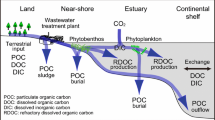
Overview
- Reviews and provides comprehensive global information on state-of-the-art science, technology, policy, and international frameworks related to blue carbon
- Presents case studies of blue-carbon science, technology and practical applications, such as the carbon offset credit in Japan
- Proposes future needs for blue-carbon initiatives
Access this book
Tax calculation will be finalised at checkout
Other ways to access
About this book
This book presents a comprehensive and innovative understanding of the role of shallow coastal ecosystems in carbon cycling, particularly marine carbon sequestration. Incorporating a series of forward-looking chapters, the book combines thorough reviews of the global literature and regional assessments—mainly around the Indo-Pacific region and Japan—with global perspectives to provide a thorough assessment of carbon cycling in shallow coastal systems. It advocates the expansion of blue-carbon ecosystems (mangroves, seagrass meadows, and salt marshes) into macroalgal beds, tidal flats, coral reefs, and urbanized shallow waters, demonstrating the potential of these ecosystems as new carbon sinks. Moreover, it discusses not only topics that are currently the focus of blue-carbon studies, i.e., sedimentary carbon stock and accumulation rate, but also CO2 gas exchange between the atmosphere and shallow coastal ecosystems, carbon storage in the water column as refractory organic carbon, and off-site carbon storage. Including highly original contributions, this comprehensive work inspires research beyond the specific regions covered by the chapters. The suite of new concepts and approaches is refreshing and demonstrates that blue-carbon research is indeed a vibrant new field of research, providing deep insights into neglected aspects of carbon cycling in the marine environment. At the same time the book provides guidance for policy makers to deliver benefits to society, for example the inclusion of blue carbon as a carbon offset scheme or the Nationally Determined Contribution (NDC) in the Paris Agreement, and also for building resilience in coastal socio-ecosystems through better management. This book is intended for all those interested in the science and management of coastal ecosystems.
Similar content being viewed by others
Keywords
Table of contents (14 chapters)
-
Front Matter
Editors and Affiliations
About the editors
Dr. Masakazu Hori is a Senior Researcher at the Coastal Macrophyte Ecosystem Research Group, National Research Institute of Fisheries and Environment of Inland Sea (FEIS), Japan Fisheries Research and Education Agency (FRA). He received a Ph. D. in Marine Environments and Resources from the GraduateSchool of Fisheries Science, Hokkaido University. He worked as a Research Fellow at the University of Tokyo and an adjunct instructor at Hiroshima University. He specializes in community and ecosystem ecology, including plant–animal interactions, food-web analyses, ecosystem services, and social-ecological systems in shallow coastal ecosystems.
Bibliographic Information
Book Title: Blue Carbon in Shallow Coastal Ecosystems
Book Subtitle: Carbon Dynamics, Policy, and Implementation
Editors: Tomohiro Kuwae, Masakazu Hori
DOI: https://doi.org/10.1007/978-981-13-1295-3
Publisher: Springer Singapore
eBook Packages: Earth and Environmental Science, Earth and Environmental Science (R0)
Copyright Information: Springer Nature Singapore Pte Ltd. 2019
Hardcover ISBN: 978-981-13-1294-6Published: 14 September 2018
Softcover ISBN: 978-981-13-4602-6Published: 11 February 2019
eBook ISBN: 978-981-13-1295-3Published: 03 September 2018
Edition Number: 1
Number of Pages: XII, 373
Number of Illustrations: 88 b/w illustrations, 64 illustrations in colour
Topics: Geoecology/Natural Processes, Freshwater & Marine Ecology, Climate Change Management and Policy, Oceanography, Sustainable Development, Ecosystems



